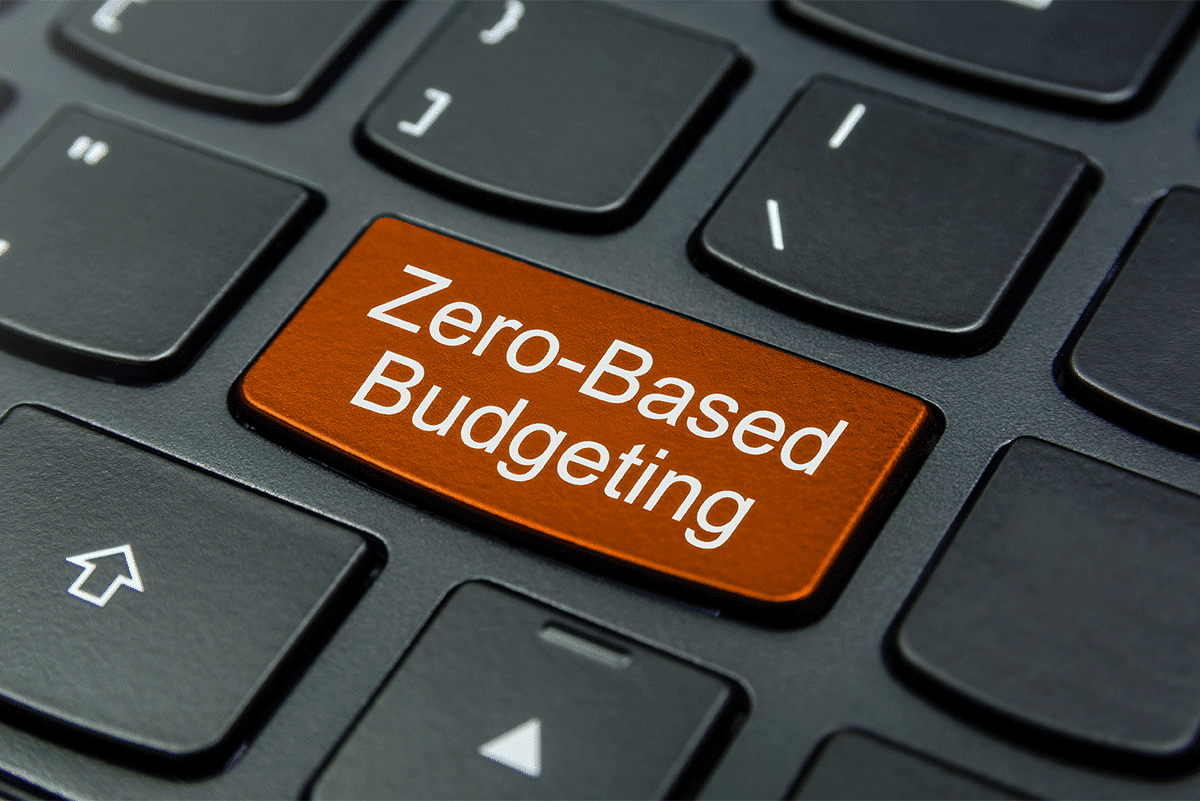Zero-based budgeting is when you allocate every dollar of your monthly income for budgeting purposes. In other words, your income minus expenses should be equal to zero. To do that, you need to ensure your monthly expenses match your monthly income, and that every dollar is being given a purpose.
Here’s an important distinction: A zero-based budget (sometimes called a zero-sum budget) doesn’t mean that you have a balance of zero in your bank account at the end of the month. It simply means your income minus expenses is equal to zero.
Let’s say your monthly income is $5,000. That means your spending, saving, giving and investing in the month should total $5,000. By doing that, you’ll know exactly where every single dollar is going.
With zero-based budgeting, most families use the same expense categories and amounts each month, but there’s nothing stopping you from mixing it up. (I’d encourage you to do that when there’s a major life change. We’ll talk about that in more depth later.)
If you have any money left over at the end of the month, it doesn’t mean you should blow it on a shopping spree. You’ll want to either add the amount to your budget for next month or allocate it to another category, such as your emergency fund.
If you’re constantly living paycheque to paycheque without a clue where your money is going, you could be setting yourself up for a rude awakening. It’s no fun to wake up one day and find a balance of zero in your bank account.
You can create a zero-based budget in a number of ways – using an app, a spreadsheet or the old-fashioned way with pen and paper. It’s totally up to you! Whatever works best for you and encourages you to budget.
Who is zero-based budgeting best for?
Zero-based budgeting is best for anyone who’d like to gain a better grasp of where all their money is going. If you’re wondering this on a monthly basis, that’s when zero-based budgeting can come in handy. By allocating every single dollar to spend, save, give or invest, you’re less likely to have money sitting in your bank account without a purpose, and thus be tempted to spend it.
Zero-based budgeting is easiest if you have regular, predictable income (i.e. you’re a salaried employee), but if you have irregular income, zero-based budgeting can work, too. In this case, it will require a little more planning. Examples of irregular income include self-employment, part-time work and commission-based income.
With irregular income, you’ll want to adjust your budget on a monthly basis based on how each month looks in terms of income and spending to ensure every dollar is allocated. It’s that easy!
When should you use it vs other types of budgeting?
Zero-based budgeting is good when you have difficulty tracking your spending in today’s increasingly cashless society. It’s good to help escape the trap of living paycheque to paycheque and does a good job of making you aware of how much money you have coming in and going out. It’s the most practical and useful budget for most families.
How often should you reassess your finances?
Although there’s no hard and fast rule about how often you should reassess your finances, a good rule of thumb is to reassess at least once a year, or whenever there’s a major life change. Examples of major life changes include a wedding, moving to a new home, the birth of a child or divorce.
These life changes can have a major impact on finances, so it’s the ideal time to review your budget and make changes as necessary. For instance, with the birth of a child, there are additional child-related expenses. Your income may also be lower if a partner is going on paternity leave.
If there isn’t a major life change, it’s a good idea to reassess your finances at least once a year. A lot can happen in a year: you might get a pay raise at work, or you might have new expenses if you, say, bought a new car or joined a gym. Reassessing will ensure that your budget is fully up to date and reflective of your day-to-day spending.
What are the pros and cons of zero-based budgeting?
Pros
- Zero-based budgeting makes you aware of how much money you have coming in and going out. It can keep you from spending money you don’t have. It really gives you a genuine sense of control over your money.
- A zero-based budget is easy to customize. This makes it especially handy if you’re new to budgeting and managing your money.
Cons
- Although zero-based budgeting is helpful, it can also take up quite a lot of time. To help keep your spending in check, you’ll need to constantly keep a close eye on your spending.
- Zero-based budgeting requires even more work for one-time costly expenses (i.e. home repairs, car repairs, replacing a broken cellphone, etc.). Unless you account for every single dollar, you could find yourself in a situation where you don’t have enough money at the end of the month to cover your expenses. The easiest way to solve this is to have emergency savings, so you don’t find yourself with a cash flow crunch.
- Zero-based budgeting also requires more work if your income is irregular. If you’re unsure about what your income will be like for the month, you might consider using last month’s income for this month’s budget (although bear in mind you’ll need to save up a month’s worth of income ahead of time to do this).
How is a zero-based budget done?
Here are the steps involved in creating a zero-based budget.
1. List your monthly income
You can do this in a spreadsheet, smartphone app or on pen and paper. Your income includes your full-time job and any extra income you earn (i.e. rental income, side hustle, small business, etc.). List all your monthly income and tally it up for your budget.
2. List your monthly expenses
Next, list your monthly expenses. The easiest way to do that is to start with a budget template with common spending categories. Everyone’s spending is different, so you’ll want to customize it based on your own spending. It’s a good idea to update your budget in the month ahead based on any money you plan to spend on the basic necessities like mortgage/rent, food and clothing.
3. List your variable expenses
Once you’ve got the essential expenses takes care of, list any variable expenses for the month ahead. Variable expenses are the infrequent expenses that come up every so often. For example, if your car needs a tune-up or you need to get your computer upgraded.
4. Subtract your income from your expenses until it’s equal to zero
Now take the total of your expenses and subtract it from the total of your income. Ideally, this will be equal to zero, although it may take a few times to get there. If the difference isn’t equal to zero, you’ll need to adjust your expenses to help get there. If you have a shortfall, you’ll need to reduce your expenses for the month. If you have a surplus, you can allocate the extra money to savings.
5. Track your spending
A budget is only handy if you use it. You’ll want to track your spending (and income) on a monthly basis. That way you can adjust your budget and/or spending to make sure your budget balances out to zero each month.
The Last Word on Zero-Based Budgeting
Zero-based budgeting is ideal for families who want to build up a savings and emergency fund account. By retaining complete control over income and expenses, shortfalls can be eliminated and surpluses can be created. Though households with salaried employees benefit the most from a zero-based budget because of predictable income, this type of budget also works with freelance income. Whatever budget you decide, sticking to it will save you money in the long run.










